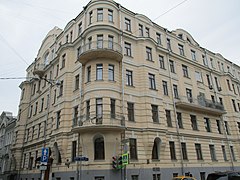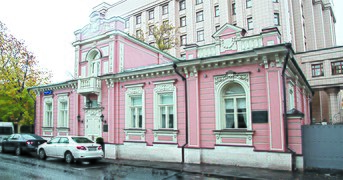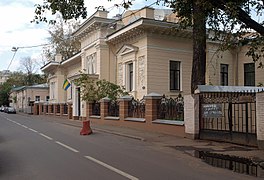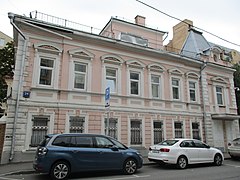Deneschnygasse
The Deneschnygasse (russ. Денежный переулок, Deneschni Pereylok ) is an alley in the district Khamovniki and Arbat in Central Administrative District of Moscow . It leads from Grosse Lyovshinsky Street to Arbat Street, parallel to the Garden Ring , behind the complex of the Foreign Ministry buildings . The length is 0.6 km. There are embassies from Italy , Chile and Gabon on the alley .
history
The alley changed its name several times. In the Middle Ages, the living quarters of the coin engravers and minters who worked for the State Mint were located there . This gave the street the name Deneschny ( monetary ). Later the street was named Jermolow and Pleschtscheew (after the last name of the house owner), also Pokrowski-Gasse . There was also the Church of the Protection of the Virgin Mary , built in 1673 , which was demolished in 1930 under Soviet rule. In 1933 the street was renamed Wesnina-Straße in memory of the architect Leonid Wesnin, who lived there. In 1994 the street got the name Deneschny again.
description
On the street are among others:
- No. 1/8 - The three-storey residential building of AF Ladyschensky, at the intersection with the Great Lyovshinsky, built in the late 18th to early 19th century in the classicism style. In 1835 it was bought by the Moscow government and used as a residential building for state officials. The architect and art collector Ewgraf Tjurin (1792–1875) lived here, who made a collection of around 400 paintings, including by Rubens , Diego Velázquez and Anthonis van Dyck , accessible to the public and planned an art museum. For this he did not get any of the buildings from the Moscow authorities. The historians Ivan Sabelin and Sergei Solovyov also lived here . Now there is an international art fund here. The building is a cultural monument of federal importance and is a listed building.
- No. 5 - The mountain mansion. Also a cultural monument of federal importance. This building is located on the site of the old wooden mansion from 1817, which was owned by the writer Mikhail Sagoskin until 1852 . At the end of the 19th century this house was bought by the merchant Sergei Berg and demolished in order to build a residential building made of stone. This was built by the architect Pyotr Boizov in the style of eclecticism , with a cladding of gray sandstone, and was one of the first to be connected to the electricity supply when Moscow was electrified . Behind the house is a garden with a fountain and an arbor in the Moorish style. In 1918 the German embassy was briefly located here. On July 6, 1918, the Ambassador Wilhelm von Mirbach was shot here by the Left Social Revolutionaries Jakow Bljumkin and Nikolai Andrejew . After that the building belonged to the Comintern ; from 1924 the Italian embassy was located here, the Japanese embassy from 1941 to 1945 and the Italian embassy again from 1949. Music concerts and art exhibitions are held here regularly. The historic interior of the building has been preserved.
- No. 7 Corps 1. - The mansion was built in 1910–1912 according to a project by the architect Adolf Seligson. Now it belongs to the Embassy of Chile .
- No. 9/5 - A house, also based on plans by A. Seligson, in which Anatoly Lunacharsky and the aforementioned J. Bljumkin lived, among others . The Lunacharsky Memorial Cabinet is located here. From 1921 to 1924 the Rudomino Library was also located there (current address Nikolojamskaya , 1).
- No. 9/6 - The Polivanov mansion. This wooden building stands on the stone foundations of an old house that was destroyed during the great fire of 1812. The new house was built in 1823 for the retired officer Alexander Poliwanow (1784-1845), who was a veteran of the Battle of Preussisch Eylau , and survived several fires in two centuries, the latter in 2001. Before the October Revolution , it served as a residential building , under Soviet rule it was nationalized and used by various organizations. During the Great Patriotic War there was a school for telecommunications troops . 1951–1954 a restoration followed, the fence and gate were restored. The last restoration was carried out in 2004 - 2007, after which the building was recognized as a cultural monument of federal importance and handed over to the Russian Ministry of Culture.
- No. 11th Corps 1 - The Tolstoy-Grachev Manor. This wooden building was built in the second half of the 18th century and extensively reconstructed in 1884. Now it belongs to the Ministry of Foreign Affairs of the Russian Federation .
- No. 12. A house built in 1907. Here lived Yevgeny Vakhtangov and Leonid Vesnin. The offices of Kamchatka and Ulyanovsk Oblast as well as the private school Pifagor and Ko and the museum apartment of Vakhtangov are located there .
- No. 13. The house Bol- Gutheil is also a monument of regional importance. It was built in 1887 by the architect Vladimir Gawrilow for the merchant Nikolai Bol, from 1892 the owner was the music publisher Karl Gutheil. Sergei Rachmaninov was often a guest here.
- No. 16/4 - The Pavlov manor house. It was built by the architect Karl Treiman in 1899–1900, and modified in 1905 by Stanislaw Kutschinski. Now the Embassy of Gabon is here .
- No. 24.1 - The house was built in 1823 for Avdotja Waskowa, later rebuilt several times (1833, 1893, 1914). In the 1890s it belonged to Agrippina Pletschko, the daughter of the historian Michail Pogodin.
Web links
Individual evidence
- ↑ Дом дворцового ведомства в Денежном переулке
- ↑ The history of the house. Official website of the Embassy of Italy
- ↑ Городская усадьба М.С.Грачева, 2-я пол. XVIII в. - XIX в
Coordinates: 55 ° 45 ' N , 37 ° 35' E







